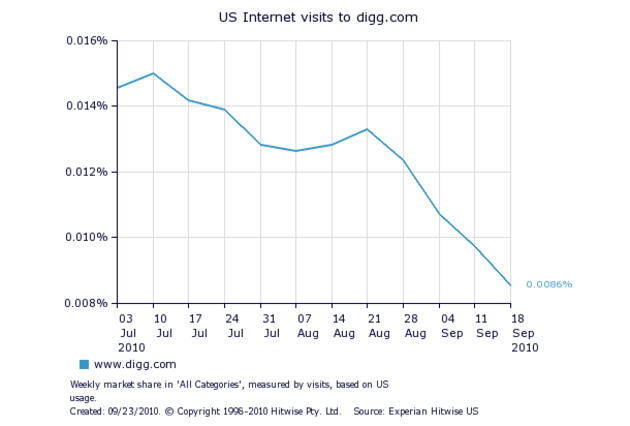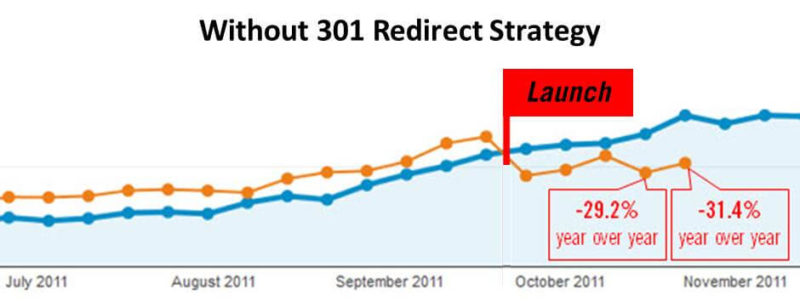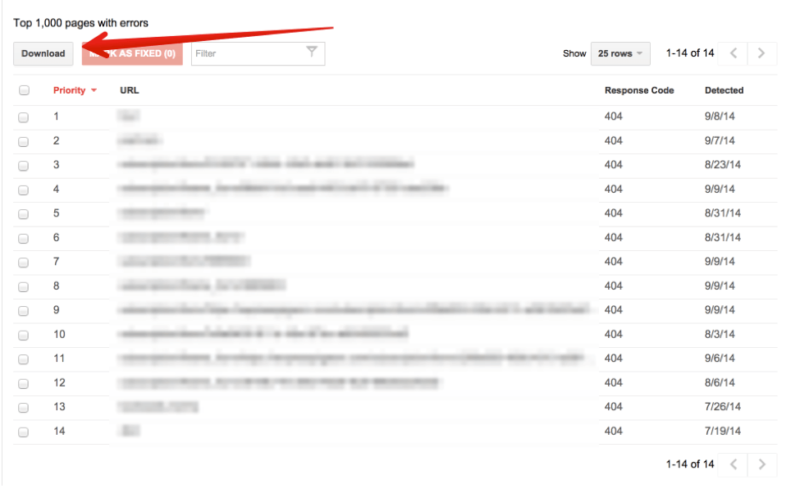How To Create A 301 Redirect Map
Overhauling your site? Without a 301 redirect map, you risk losing valuable search equity.
If you redesign your website, you need to create a 301 redirect strategy. At the core of this strategy is making a 301 redirect map.
If you launch a new website without a 301 redirect strategy, the website redesign will be a failure because you will lose a lot of traffic. When Digg redesigned its website, for example, it lost vast amounts of traffic.

Image from readwrite.com.
Similarly, Jill Kocher of Practical ECommerce reported on a consumer product manufacturer’s site that had recently relaunched:
After averaging consistent 30 percent improvements in weekly organic search traffic year over year, the site suddenly began losing up to 31 percent of its organic search visits the week of the launch. This could have been avoided if the URL changes had been implemented in conjunction with a 301 redirect strategy.
The only way to preserve your traffic from this revenue-ruining freefall is through a 301 redirect strategy.
Any SEO with a standard skillset should be able to make a redirect map. The process that I will explain below does not require any coding skills, htaccess meddling, Apache stuff, or expensive programs.
Who Should Use This Guide?
This how-to guide for creating a 301 redirect map is meant for SEOs that help with website launches. You may want find this guide helpful if:
- You are assisting in a website launch (i.e., SEO website launch support)
- You are helping a site regain traffic after a website launch
- You are the SEO helping a team of developers during a website redesign
- You are assisting with search strategy on a content refresh, architecture change, or CMS change
When Do You Create A 301 Redirect Map?
The 301 redirect strategy should be a part of your timeline at the very beginning of any website redesign. However, you won’t be ready to create an actual workable map until the redesign URLs are created. Sometimes, this doesn’t happen until the very end of the redesign process.
When all the new URLs are created, it’s time to make the map.
How To Create The 301 Redirect Map
In this step, your role as the SEO is not to implement the redirects, but to map the redirects.
The process is simple enough that all you need is Excel and a lot of time. Using Google Spreadsheets probably isn’t going to cut it in this case. Some Excel wizards may be able to create some powerful sort techniques, especially for particularly large sites.
1. Gather
Obtain a list of all the revamped URLs for the new site design. At the same time, develop a full list of all the original URLs from the old site. Your developers may be able to provide these lists, or you can assemble them using a crawling app. I used Integrity for Mac; Screaming Frog works, too.
2. Compare
Place the two lists side by side in a single Excel sheet.
3. Map
Now, match each old URL with its corresponding new URL. For the most part, this is going to be a fairly straightforward process. It will be obvious, for example, that the “About Us” page on the old site is going to redirect to the “About Us” page on the new site, etc.
Some pages won’t be so obvious, and you’ll have to make your best guess for where to redirect it. Using filtering rules in Excel, you can find common words in the URLs, and automatically match old ones to the new.
(Note: For sites with millions of pages, automating the process is essential.)
4. Hand Off
Once you’ve developed a full 301 redirect map, give it to the developers for implementation.
Testing Your New Site’s Redirects
After the site is launched, the most important thing you can do is to test the 301 redirects. Using a crawler, create a report of the server status for each page. Take note of any errors, and address these by referencing your 301 redirect map.
The simplest way to check for problematic redirects is to use Google Webmaster Tools.
- First, log in to Google Webmaster Tools and select your site
- Click Crawl → Crawl Errors
- In the display, click “Not Found”
The “Not Found” report provides a tabulation of all the pages on your site that people tried to access, but received an 404 (Not Found) error.
Sometimes, 404s are the result of user error. Maybe the user manually typed in a URL page on your domain, but misspelled it — www.example.com/abuot-us (misspelling “about-us”). The user will receive a 404, and you can just ignore it, since it’s not a major source of errors for most users.
If, however, you have 404 response codes appearing on pages that existed on the previous URL taxonomy, then those pages need to be redirect properly. It could be that the 301 redirect was misspelled or never implemented in the first place.
Here’s a look at one site’s Google Webmaster Tools report that is registering several 404s — 14 in total. This isn’t a bad number, actually. Some sites with recent redesigns may see 404 reports in the tens of thousands.
To check each individual 404 error, you can download the entire chart of errors into .csv or Google Docs.
This gives you a working document for comparing your initial list of 301s.
A more straightforward method of auditing 301 redirects post-launch is to use a tool like Screaming Frog that is designed for this purpose.
To use Screaming Frog’s 301 checking feature, you can:
- Upload all old URLs
- Tell Screaming Frog to “always follow redirects,” (Configuration → Spider → Advanced) and run a report
(I recommend Screaming Frog’s article on the topic for a more in depth treatment.)
Even after you’ve conducted an initial test, it’s helpful to keep an eye on your Webmaster Tools for a while. If you notice any URL errors, be sure to fix them as quickly as possible.
Conclusion
The process of implementing a 301 redirect strategy is more time-consuming and comprehensive than a simple article can convey, but it’s essential.
Redesigning or migrating a website is often a nightmare for an SEO, and you may experience a temporary period where everything seems like it’s careening out of control. The only recourse for preventing permanent, significant traffic loss is a robust and airtight 301 redirect map.
What tips, hacks, or techniques do you use in creating your 301 redirect map?
Opinions expressed in this article are those of the guest author and not necessarily Search Engine Land. Staff authors are listed here.
Related stories
New on Search Engine Land



